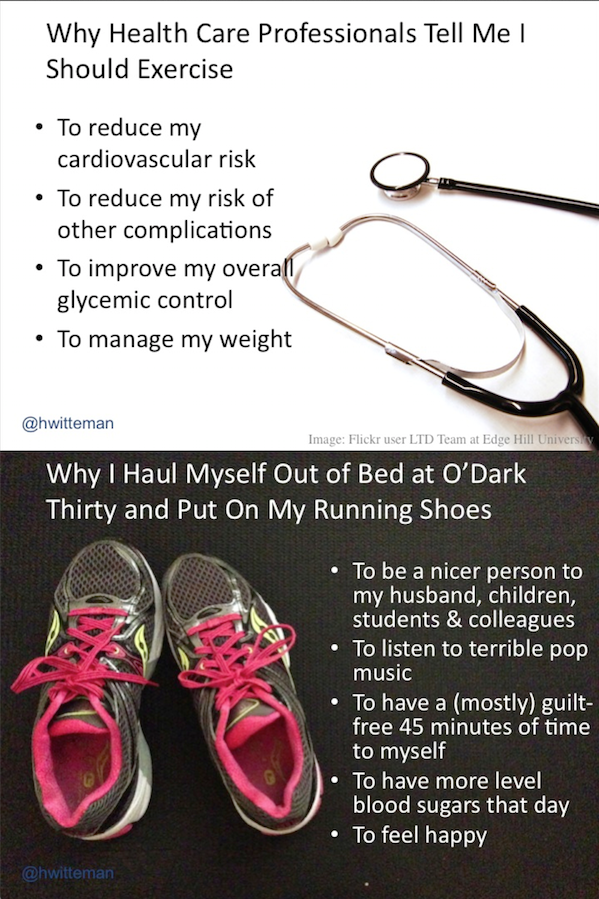Last night, I glanced at twitter just before going to sleep. (Rarely a good idea, I know.)
I noted a tweet posted by the account of the editor of the Journal of General Internal Medicine, a high impact and generally (no pun intended) excellent journal:
Simple experiment in #JGIM finds that #diabetes feedback using grades, smiley faces doesn't help. #backtodrawingboard http://t.co/BOPaLPR68M
— Richard Kravitz (@jgimeditor) July 2, 2014
(Link to tweet for those for whom the embed doesn’t come through.)
My frustrated response last night:
Shockingly, telling ppl they're failing fails to inspire them. MT @jgimeditor #A1c grades, faces don't help http://t.co/uEq4mmnjEO #diabetes
— Holly Witteman (@hwitteman) July 2, 2014
(Link to tweet for those for whom the embed doesn’t come through.)
Basically, this is a randomized controlled trial in which people with diabetes (type 1 or type 2) with A1c >8.0% got their A1c (Note 1) results either in standard percentage format, with a letter grade (A, B, C, D or F) or as one of 5 faces, ranging from smiley to frowny with tears running down. The researchers titled the reports, “YOUR DIABETES REPORT CARD.”
Note 1: A1c is shorthand for HbA1c. It is sort of like an average of your blood sugar over the past 3 months. People without diabetes typically have an A1c between 4.0% and 6.0%. A common target for people with diabetes is to keep their A1c under 7.0%.
Bottom line: Neither grades nor frowny faces helped people understand their A1c better. They didn’t result in greater reductions in A1c, either. The study also showed that people with higher numeracy (like literacy, but with numbers) understood their A1c better than people with lower numeracy.
The researchers based their design on solid previous research, like you are supposed to. And of course it’s always worth trying promising approaches.
But here is the thing, and what brings me to the title of this post: I think if they had asked people with diabetes early on in their design process, they would have received feedback that would have helped them design something better.
I participated recently in a big brainstorming team meeting for a project about how to best display laboratory blood test results for people with diabetes. I was there in a scientific capacity (I am co-investigator on the project), but was also able to draw on my decades of experience of living with diabetes. There were also other people there on the research team whose role was specifically to bring their perspectives as people living with diabetes.
Early on in the brainstorming process, among many other ideas, things like letter grades and smiley faces were suggested. And every single one of us who has lived with the disease explained how those would make us feel awful rather than motivated. There is already so much morality tied up in A1c results. I, personally, feel like a failure if my A1c is above my target. Piling it on with poor grade or a frowny face would likely make me avoid thinking about it, and would definitely not be motivating.
The authors of the study reported above (who are excellent researchers in behavioral economics in health and very smart people!) justified their design choices by citing usage of these kinds of displays in other contexts. For example, letter grades are used to indicate the quality of hospitals or of restaurant health inspection reports, and there was an experiment in California in which smiley/frowny faces on people’s utility bills to indicate how people were doing compared to their neighbours encouraged people to save power.
But, again, here’s the thing: unless you are having money struggles, the emotional weight of a utility bill is probably not the same as the emotional weight of a report on your health. I suspect that this difference is obvious to many people whose lives literally depend on these numbers.
I do not know if this research team had patient partners, but reading their paper, it doesn’t sound like it. They don’t describe pilot testing, either. Admittedly, they may have done these things and not written about them. Word counts are strict, and it can be tough to squeeze everything in. But I’ve read a lot of papers in this area and this one reads to me like the researchers, for whatever reason, didn’t have patients involved until they recruited them into their trial.
As a researcher, I recognize that it can be daunting to bring patients onto a research team. I think some researchers are afraid that it might make things take longer (a very bad thing in competitive research). However, I, personally, have found the opposite. When I’ve been able to involve patient partners on my research teams and when I’ve participated on other similar research teams, every single one of those colleagues has brought valuable and novel insights to the table. Most relevant to the study described above, these people have saved our research projects countless trips down wrong paths.
Funding organizations and journals are increasingly encouraging or requiring researchers in the health sciences to include patients, families, and other stakeholders in the planning stages and throughout projects. For example, the Patient-Centered Outcomes Research Institute requires this, and they have patient reviewers on their panels. (Disclosure: I hold funding from this organization.) The British Medical Journal is requiring statements of how patients were involved in research projects, and has patient reviewers.
As someone who was a patient for decades before I was a researcher, I think these are wonderful developments, and I could not be happier to see these ideas picking up steam. I think it will help everyone and will improve research.
So, to my fellow researchers, I say: Make your research more efficient and impactful. Invite patient partners to join your research teams. (And if you don’t know where to start, here is some guidance.)



2 thoughts on “Why you want patient partners on your research team”